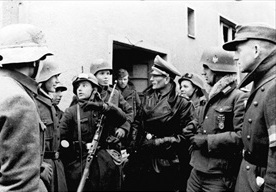NAZI TO LEAD GERMAN LUTHERANS
Berlin, Germany · September 23, 1934
On this date in 1934 Ludwig Mueller, a crew-cut former naval chaplain, was installed as the new Reich Bishop in a gaudy spectacle at the swastika-bedecked Berlin Cathedral. The year before, German chancellor Adolf Hitler had proposed, as part of an administrative overhaul of the German Evangelical (Lutheran) Church, creating the office of Reichsbischof. The overhaul was intended to bring together the loose federation of 28 independent regional church bodies into a unified church that resembled the Church of England under its senior bishop, the Archbishop of Canterbury.
Hitler wanted the new Reichskirche (German church) ordered along Nationalist Socialist lines. This Gleichschaltung, or synchronization as it was known in Germany, was really forcible coordination. So it was that the roughneck Mueller, a Nazi Party member since 1931, was Hitler’s man for the job. He led the effort to merge the church’s youth groups, Evangelische Jugend (600,000 strong in 1934), with three paramilitary organizations of the Nazi Party: the Deutsches Jungvolk (for boys ages 10 to 14), the Hitlerjugend (14-to-18-year-old boys), and the Bund Deutscher Maedel (League of German Girls).
Mueller was tough on theology, too. An anti-Semite, he championed a revisionist view of “Christ the Aryan,” or a “heroic Jesus.” He made plans to cleanse German Christianity of what he termed “Jewish corruption” and endorsed purging large parts of the Old Testament. Not surprisingly, Mueller was the chief nemesis of the Confessing Church (Bekennende Kirche), an opposing synod of German Lutherans in which Dietrich Bonhoeffer—theologian, pastor, and author (The Cost of Discipleship, or Nachfolge in German)—played a leading role. The Confessing Church rejected the Nazification of the German church and its pseudo-Christian congregants, called “German Christians” (Deutsche Christen).
Mueller’s star began fading in the mid-thirties as the Lutheran schism prompted the Nazi Party to take a more aggressive stance toward the resistant Christian clergy. Mueller tried re-inveigling himself into the good graces of the Party by allowing the Gestapo (German secret police) to monitor his churches. The 1945 apocalyptic finale of the Third Reich saw the end of Reich Bishop Mueller, too, who took his life on July 31, 1945.
![]()
German Church Leader Ludwig Mueller and Nazi Paramilitary Organizations for German Youth
 |  |
Left: Already a Landesbischof of a regional Lutheran synod, Ludwig Mueller is shown behind a swastika-adorned lectern addressing German Christians (Deutsche Christen, actually pseudo-Christians) following his installation as Reichsbischof (Reich Bishop) of the German Evangelical Church (Deutsche Evangelische Kirche), Berlin Cathedral, September 23, 1934. Mueller (1883–1945) was an ardent advocate of “dejudaizing” the German church (Reichskirche) and indoctrinating its youth with Nazi racist ideology through paramilitary organizations.
![]()
Right: Membership in the paramilitary Hitlerjugend (Hitler Youth) for 14-to-18-year-olds was compulsory after 1936. In 1939 the law was amended to make membership in the Deutsches Jungvolk (10-to-14-year-olds) and the Hitlerjugend mandatory for all Germans males between 10 and 18 years of age. Parents could be fined or imprisoned for failing to register their children. With the outbreak of war members in the Hitler Youth were fed into the German Wehrmacht (armed forces) or the National Labor Service (Reichsarbeitsdienst), where 18-to-24-year-olds were required to serve six months before entering military service. In this photograph, a Hitler Youth company of the Volkssturm (home guard) is at the German-Soviet front in Pyritz, Pomerania (today Pyrzyce, Northwestern Poland), February 1945. During the Battle of Berlin (April 16 to May 2, 1945), Hitler Youth and even some pre-teen Deutsches Jungvolk formed part of the last line of German defenses and were reportedly among the fiercest fighters.
 |  |
Left: The League of German Girls (Bund Deutscher Maedel) used campfire romanticism, summer camps, folklore study, tradition, and sports to educate girls within the National Socialist belief system, and to train them for their main roles in German society: wife, mother, and homemaker. Sports included swimming, running, long jump, somersaulting, tightrope walking, and marching. Before entering any occupation or advanced studies, the girls, like the boys in Hitler Youth, had to complete a year of land service (Landfrauenjahr). Although working on a farm was not the only approved form of service, it was a common one; the aim was to let city youngsters experience life in the countryside, hoping they would then stay there in service of Nazi “blood and soil” (Blut und Boden) beliefs, which placed a high value on the virtues of rural living. After the outbreak of war, many young women became “Blitzmaedel,” or female combat soldiers.
![]()
Right: Deutsches Jungvolk (German Youth) recruits line up for roll call at a rally in Berlin in 1934. For boys ages 10 to 14, Deutsches Jungvolk was a section of the Hitler Youth movement. Through a program of outdoor activities, parades, and sports, it aimed to indoctrinate its young members in the tenets of Nazi ideology. Membership became compulsory for eligible boys in 1939. By the end of World War II, some Deutsches Jungvolk had become child soldiers.
Henry Metelmann on the Impact of Nazism on Young Germans. A BBC Production
![]()

 History buffs, there is good news! The Daily Chronicles of World War II is now available as an ebook for $4.99 on Amazon.com. Containing a year’s worth of dated entries from this website, the ebook brings the story of this tumultuous era to life in a compelling, authoritative, and succinct manner. Featuring inventive navigation aids, the ebook enables readers to instantly move forward or backward by month and date to different dated entries. Simple and elegant! Click
History buffs, there is good news! The Daily Chronicles of World War II is now available as an ebook for $4.99 on Amazon.com. Containing a year’s worth of dated entries from this website, the ebook brings the story of this tumultuous era to life in a compelling, authoritative, and succinct manner. Featuring inventive navigation aids, the ebook enables readers to instantly move forward or backward by month and date to different dated entries. Simple and elegant! Click 











